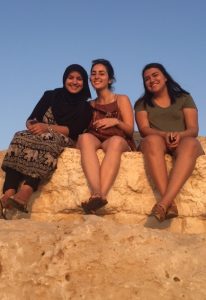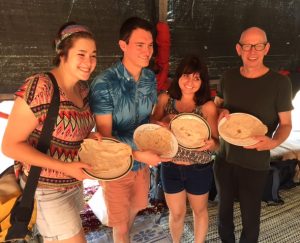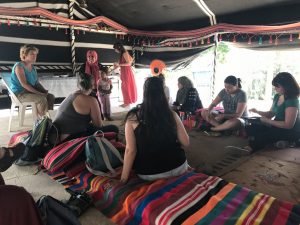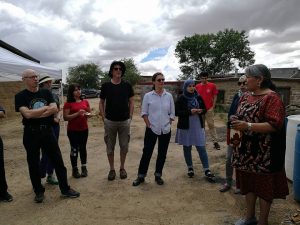By Carly Banks
NAU Communications
Dual citizen Noemi Uribe was one of nine NAU students to ever study abroad in Israel.
She grew up in working-class Phoenix, and after her father lost his job, her family of six was forced to move back to Mexico. Relocating to a new city every six months for more than five years, she never really felt like she had a home. In order to boost her chances of getting into college, Uribe returned to the U.S. at the age of 16 to finish her high school career. A full scholarship to NAU made her decision to move north an easy one, and here, she found home.
In her senior year, she heard about the first-of-its-kind study abroad opportunity through Björn Krondorfer, one of her religious studies professors. She was anxious to explore life outside of the familiar Southwest and, having been raised as a Protestant, Uribe always hoped to have the chance to visit the Holy Land.
“As a minority in the U.S., traveling to another country where I was considered just another American tourist was, in a way, empowering,” Uribe said. “My voice and opinion was valued more than ever, and I was categorized by the local people as just part of a majority group rather than singled out or separated into a subcategory the way it happens here. It’s hard to explain, but for once I began to understand the privilege white Americans experience.”
Whether she knew it or not, Uribe carried her cultural perceptions with her to Israel, and her study abroad experience was much different than her fellow travelers because of it—as was their experience from hers and each other’s.

This was exactly what Krondorfer had hoped for when he co-created the Borders, Identities, Social Repair: Majority Cultures and Indigenous Lives study abroad program.
The program was a product of a unique partnership between Northern Arizona University and Ben-Gurion University of the Negev in southern Israel—two universities, more than 7,000 miles apart, connected by two people—Ralph and Doris Martin.
Krondorfer, director of NAU’s Martin-Springer Institute, and professor Shifra Sagy, the director of the Martin-Springer Center for Conflict Studies at BGU decided to capitalize on this common dominator in hopes of providing students an immersive look at the powers of discrimination—the reason behind the donation in the first place. Over the course of a year and a half, they created what they believed to be the first educational program to focus on cultural encounters.
The three-week joint partnership program provided an opportunity for NAU and BGU students to spend eight days in Israel and eight days in Arizona and look at what Krondorfer calls the minority-majority relationships in each region.
“In southern Israel, we looked at the Bedouin population in relation to the majority Jewish population in Negev,” Krondorfer said. “And then we did the same here looking at Hopi and Navajo reservations in relation to majority culture in Arizona.”
The program offered students an intense learning experience focusing on three different components: academic, where they would learn about the history of these places and cultures; field trips, where they would be exposed to historical sites and traditions; and emotion, where students had the opportunity to share, discuss and think about different cultures and social identifiers and how perception played a part in that.
Nine U.S. students and five Israeli students from all areas of study participated in the program—coming from a variety of cultural backgrounds ranging from Native Americans to Israeli Jews.
“We had students from marketing, health sciences, religious studies, English, sustainable communities and applied indigenous studies,” Krondorfer added. “This was the perfect scenario because everyone brought their own set of cultural experiences that played a part in how different things were perceived.”

Senior Alec Chavez also embarked on the journey overseas. He is the youngest of four siblings and grew up in a nice California suburb. He attended good schools, was raised Christian and is multi-ethnic—Latino and American.
Like many young Americans, he grew up knowing about the conflicts in the Middle East. But after spending time in the heart of the conflict zone, his perceptions were upended.
“Getting to know Jewish and Muslim students and sharing in one another’s culture on this trip showed me that most people are not that different from one another,” Chavez said. “I learned that we know nothing when it comes to the issues and struggles of others in the world. Seeing how complex things are in Israel opened my eyes to the ignorance shared by most Americans.”
Every student on the trip took away something different. It was more than learning from locals how to make lip balm from scratch, or spending the day making pita bread over an open fire.
“We talked about power, fear, racism, privilege and other typically theoretical topics brought to the real world,” Chavez said. “It was a shocking, challenging and somewhat emotional experience that exposed me to issues that crossed cultural boundaries.”
The students would spend time discussing the day’s activities, what they learned and assessing how everyone’s analysis of the day differed. It was a chance to introduce one’s self to a new world, and in some cases, a new self.

“In Israel, there was a night where I was able to share my experience as a minority to the white American students, which was very uncomfortable and hard for me,” Uribe recalled. “But that was the night I realized how important it was for me to share my reality and experiences because it can be the eye opener or defining moment for others. That night I learned the true cost of teaching and learning.”
The trip weighed on the students. Whether it stemmed from hearing stories of successful Bedouin women, who shared how they defied the odds and broke cultural norms in order to help empower women; witnessing a Kachina Rain dance on the Hopi mesa, a rare glimpse at this sacred ritual; or listening to a Bedouin man discuss the hardships, abuse and unjust treatment he faced despite the fact that he had served in the Israeli army, the students struggled with the exposure to raw culture.
But then again, this wasn’t your typical study-abroad experience.
“I expected it to be just another trip where I visited neat places and returned home with great memories and souvenirs, but that was not the case,” Uribe said. “I think I learned more about myself being challenged there than I ever did in any class, seminar, workshop or experience here in the U.S. We weren’t tourists, we were visitors, and I imagine I will continue to process and learn from this experience for days, months and years.”
The students returned to the United States with their new Israeli friends for the second half of the session, this time, studying the relationship the minority Native Americans have to the majority culture in Arizona.
“Most of the NAU students were not as excited for this portion of the trip, because they assumed they already knew everything about the culture here,” Krondorfer said. “But, as it turned out, they realized how little they knew about their Flagstaff neighbors.”

From visiting Grand Falls to exploring the reservation and witnessing traditional Hopi dances, the students were introduced to a new side of Native American culture.
“This experience taught me that there’s a whole world out there to learn from. Our experiences and perceptions are shaped by our identities, and I’ve learned the importance of this when interacting with others who are different from myself,” Uribe said. “As a minority in the U.S., it is not my job to teach or tell others about their privilege, but to be aware of how I use my voice to create change in the most effective way possible.”
“I saw the face of poverty, privilege and those marginalized in a real and practical way both in Israel and in the U.S. I realize now I know nothing at all about the world.”



